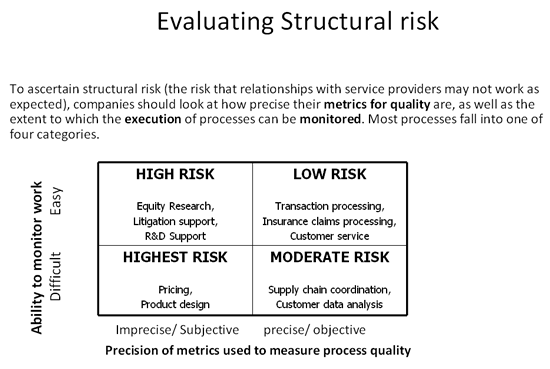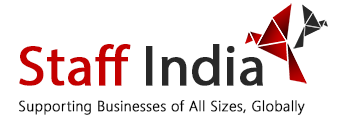How to Manage and Mitigate Offshore Outsourcing Risks - Structural
Structural risk is the result of opportunistic behavior, according to Aron. The supplier cuts corners or puts in less than the expected effort. Or the supplier insists the buyer pay for supplier mistakes.
Here are three ways suppliers do this:
- Deliberate underperformance or shirking
- Poaching or the deliberate misappropriation of information
- Opportunistic renegotiation of the contract or other opportunistic behaviour
Here are some real life examples. In claims underwriting, a property and casualty insurance company requires its supplier to check for 25 compliance factors. The supplier, however, cuts corners and only looks at 18-20 factors.
In ITO, a buyer signs a contract that promises that the provider's veteran programmers and systems analysts will work on the project. But when work commences, the supplier replaces some of the experienced team members and sends rookies who cost a lot less.
These are examples of deliberate underperformance.
Here's an example of opportunistic misuse of information. The supplier's sales staff gets a bonus if its call center staff signs up a certain number of new credit card holders. To boost sales, the supplier's staff offers the customers a lower APR than the buyer wants. Now the buyer has a lower yield on its card portfolio.
An example of opportunistic behavior typically happens after 18 months into a contract when the power shifts from the buyer to the supplier. The supplier suddenly demands a higher price for the contracted services or insists on lowering SLA levels, knowing it now has more bargaining power. "This clearly violates the spirit of the contract," says the professor.

Source: Ravi Aron
Managing structural risk
Aron says there are four ways to manage structural risk:
- Build transition service clauses into the contract. Aron suggests adding sunset clauses to any new contract, which gives the buyer an additional year of service at the same rate. "Twelve months buys a company enough time to find another supplier and transition the process completely," he observes.
- Use multiple suppliers. Switching suppliers is expensive. The best way to avoid switching is to not be completely reliant on any one provider. This guards against lock-in and switching costs. "The best case examples in supply chain management are where no manufacturer has just one supplier," he points out. ITO buyers "are just waking up to this realization," he adds. In BPO, he suggests splitting the work by volume and process type.
- Retain residual capacity. The goal of outsourcing is to reduce costly in-house capacity. "But don't lose it entirely," cautions the professor. "If you have the capacity in house, it will keep your offshore supplier from playing games with you," he continues. Retaining strategic residual capacity also gives buyers the comfort they can immediately take important tasks back in house if the supplier starts misbehaving.
Aron says the economics of labor arbitrage make it difficult for a company in these hard times to keep expensive labor on its domestic payrolls. But the professor says it's necessary insurance. He says residual capacity of 6-12 percent is sufficient in most BPO contracts.
- Monitor and control. The professor says continuously monitoring what's happening "will go a long way in stopping the provider from taking liberties, shirking, or deliberately underperforming. It's a great deterrent."
Aron says turning a supplier into a business partner also mitigates this risk. He suggests buyers add one element to an SLA that is an intangible composite of many desirable aspects of the relationship: customer satisfaction. "This makes the supplier aware it has a mandate beyond the routine delivery of work. Now it has to step into the business context of the buyer," he explains. He says the most successful outsourcing relationships he has observed have both granular metrics and customer satisfaction criteria.
The use of customer satisfaction criteria in
addition to SLA-based metrics of output quality
can drive significantly higher quality outcomes.
The buyer tells the provider the buyer's
in-house managers are its customers; periodically
the buyer will survey them, providing customer
satisfaction scores (CSS). The CSS ratings
determine a portion of the payment the buyer
receives.
CSS scores cause the provider to "sense and respond" to the business
context of the buyer. The provider understands that there are aspects of the
relationship that the buyer can't easily specify via a system of metrics but
are nevertheless important. It invests in understanding the business context
of the buyer and offers true relationship management.
The contractual governance of the relationship
changes to a "sense and respond" mode
of governance. For business transformation this is necessary; the provider must
go beyond the routine delivery of services. In many BPO and ITO contracts that
Professor Aron has studied over the past seven years in several countries, the
contracts that incorporated CSS scores outperformed those that did not both in
terms of the quality of work from the offshore provider and the buyers' managers'
satisfaction with the offshore service center.
Composite risk
This risk is characterized by a deliberate erosion of competency in the buyer's organization since it sent those skills abroad.
The extended organizational form
Aron says the extended organizational form (EOF) "contains in great measure all three risks." The EOF "bridges the strengths of both organizations" by letting the provider's employees report to the buyer's management. "The buyer's manager treats them as if they were its own employees," explains Aron. While there is no direct employee relationship between the buyer and the provider's employees, this allows the buyer to divest financial control while retaining operational control.
The buyer's managers then monitor operations, inspect
the quality after execution, and exert direct managerial
control. "Surprisingly, it also provides operational
benefits to the supplier," says Aron. Over a
period of time the provider's costs fall without
compromising the quality of work.
There is another reason to consider this form of
offshore outsourcing. In the current environment
there is some possibility of legislation that will
discourage companies from offshore outsourcing work.
That legislation may take the form of not allowing
U.S.-based firms to take tax deductions for the operations
of their captive centers offshore. The expense becomes
fully tax deductible if the buyer outsources these
operations.
Some firms may fear the loss of control that may
result from outsourcing operations to a third-party
company. This is where the EOF plays a role. It allows
firms to exert operational and strategic control
over their offshore operations without having to
carry these expenses on their balance sheets. The
EOF thus brings together the best features of both
forms of governance: Outsourcing brings the discipline
of the market to the cost of operations while captive
centers give the client firm higher levels of strategic
control. The EOF is subject to the discipline of
the market even while it allows the client to exert
strategic and operational control over the offshore
service center.
In these difficult economic times, it provides a
compelling rationale for offshore services. Combining
the EOF with careful use of CSS criteria in contracts
allows buyers to move towards transforming their
offshore service providers into strategic partners.
Companies such as Wipro are taking up initiatives
to address buyers whose objectives not only include
cost savings but also making a strategic business
impact. Wipro's PACE initiative seeks to combine
multiple business objectives including:
- Reduce cost
- Transform the cost structure from fixed to variable cost
- Earn better yield on infrastructure and asset utilization
- Create a strategic partnership between the two players
Lessons from the Outsourcing Journal:
- Knowledge transfer and management, metrics, transition management, and monitoring help mitigate operational risks in offshore outsourcing.
- Building transition clauses into the original contract, using multiple suppliers, monitoring, and retaining residual capacity reduce structural risk.
- The extended organization form, where the provider's employees report to the buyer's manager, is a great way to mitigate operational, structural, and composite risks.
Wipro set up the Council for Industry Research, comprised of
domain and technology experts from the organization, to address
the needs of customers. It specifically looks at innovative strategies
that will help them gain competitive advantage in the market. The
Council in collaboration with leading academic institutions and
industry bodies studies market trends to equip organizations with
insights that facilitate their IT and business strategies. For
more information on the Research Council visit www.wipro.com/industryresearch
or email industry.research@wipro.com.
Publish Date: June 2009 outsourcing-offshore.com
Back Office Fields
- Telemarketing
- Book Keeping
- Data Entry
- Virtual Assistant
- Transcripting
- Call Center Agents
- Email Chat and Support
- Help Desk
- Human Resources
- Proof Reading
IT Fields
- C++
- SQL
- Vb.net
- Web Design
- C#
- Asp.net
- Website Developer
- Java
- I.T Support
- Dreamweaver
General Fields
- Marketing
- SEO Internet Accounting
- Social Networking
- Blogging & Forums
- PPC Internet Marketers
- Technical Support
- Financial Analyst
- Advertising
- and many more...
- Please enquire
